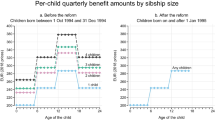Abstract
Public opinion surveys indicate that Americans list crime high in their priorities for government attention. Inevitably, public officials seeking office promise to reduce crime (the issue of crime is politicized). Simple solutions, without regard to their effectiveness, are politically popular and get votes for elected officials. The result is that social policy is made on the basis of popular solutions, followed by the spending of vast amounts of government revenue on ineffective measures. Not only is much of those funds wasted, a loss to society is further aggravated in that these resources could have been invested in programs that would yield the desired benefits. This paper examines two expensive crime-fighting measures that are failed policies and suggests one alternative type of human capital investment that is cost effective.
Similar content being viewed by others
References
Brearly, M.; Hitchfield, E.A Guide to Reading Piaget, New York, NY: Schocken Books, 1966.
Clark, C. S. "Prison Overcrowding: Will Building More Prisons Cut the Crime Rate?,"CO Researcher, 4, 1994, pp. 99–106.
Edwards, Willie J. "Predicting Juvenile Delinquency: A Review of Correlates and a Confirmation by Recent Research Based on an Integrated Theoretical Model,"Justice Quarterly, 9, 4, 1992, pp. 553–81.
Flavell, J.The Developmental Psychology of Jean Piaget, New York, NY: Van Nostrand, 1965.
Greenwood, Peter W. "Three Strikes and You're Out: Estimated Benefits and Costs of California's New Mandatory Sentencing Law,"RAND Research Review, XIX, 1, October 1995 (reprinted inOvercrowded Times, 6, 5, October 1995, pp. 2–3.
Hunt, J. M.Intelligence and Experience, New York, NY: Ronald Press, 1961.
Marvell, T. B. "Is Further Prison Expansion Worth the Cost?,"Federal Probation, 58, 1995, pp. 59–61.
Media Monitor. “Media Crime Wave” Continues—Crime Tops TV News for Second Year,"Overcrowed Times: Solving the Prison Problem, 6, 2, 1995, p. 5.
Methvin, E. H. "Doubling the Prison Population Will Break America's Crime Wave,"Corrections Today, 54, 1992, pp. 28–40.
Mauer, Marc. "Russia, United States World Leaders in Incarceration,"Overcrowed Times: Solving the Prison Problem, 5, 5, October 1994, pp. 1, 9–10.
Moore, W. J. "Locked In,"National Journal, 26, 1994, pp. 1784–94.
Piaget J.Six Psychological Studies, New York, NY: Random House, 1968.
__.The Psychology of Intelligence, Totowa, NJ: Littlefield, Adams, 1960.
Piaget, J.; Inhelder, B.The Psychology of the Child, New York, NY: Basic Books, 1969.
Piaget, J.; Inhelder, B.; Szeminska, A.The Child's Perception of Geometry, New York, NY: W. W. Norton, 1964.
Proband, Stan C. "Corrections Costs Lead State Budget Increases for 1995,"Overcrowed Times: Solving the Prison Problem, 6, 2, April 1995, pp. 1,8–9.
Rasmussen, David W.; Benson, Bruce L.The Economic Anatomy of a Drug War: Criminal Justice in the Commons, Lanham, MD: University Press of America, 1994.
Reuter, Peter; Kleiman, Mark. "The Dismal Economics of the War on Drugs," in Carl B. Klockers; Stephen D. Mastrofski, eds.,Thinking About Police: Contemporary Readings, 2nd ed., New York, NY: McGraw-Hill, 1991.
Schiraldi, Vincent. "Corrections and Higher Ed Compete for California Dollars: Corrections Winning,"Overcrowed Times: Solving the Prison Problem, 5, 3, June 1994, pp. 7–8.
Schweinhart, Lawrence J.; Barnes, Helen V.; Weikart, David P.Significant Benefits: The High/Scope Perry Preschool Study Through Age 27, Ypsilanti, MI: High Scope Press, 1993.
Smilansky, S.The Effects of Sociodramatic Play on Disadvantaged Preschool Children, New York, NY: John Wiley, 1968.
Williams, Vergil L.Dictionary of American Penology: A Revised and Expanded Edition, Westport, CT: Greenwood Publishing Group, 1996.
Zimring, Franklin. "The Voodoo Economics of California Crime,"Overcrowed Times: Solving the Prison Problem, 5, 5, October 1994, p. 3.
Author information
Authors and Affiliations
Rights and permissions
About this article
Cite this article
Williams, V.L., Williams, V.A. Prisons, drug interdiction, and preschool programs: Alternative human capital investments. International Advances in Economic Research 3, 81–90 (1997). https://doi.org/10.1007/BF02295003
Issue Date:
DOI: https://doi.org/10.1007/BF02295003




